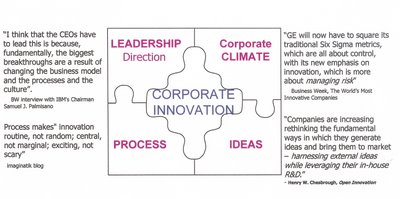
A FORMULA FOR FAILURE
Creating a corporate climate conducive to innovation is of course a critical component of the overall effort. We talked about this earlier. BUT, how do you do it? As part of the tremendous article in the July 10, 2006 edition of Business Week, a "Formula for Failure" was discussed. These are the type of things we can begin to think about to impact our Corporate Climate. Remember in my last note, change requires the full commitment and action of leadership!! I will summarize the BW article with my editorial comments.
Formalize Forums For Failure
To keep failures and the valuable lessons they offer from getting swept under the rug, carve out time for reflection. GE has recently begun sharing lessons from failures by bringing together managers whose “Imagination Breakthrough” efforts are put on the shelf.
Move The Goalposts
Innovation requires flexibility in meeting goals, since early predictions are often little more than educated guesses. Intuit’s Scott Cook even suggests that teams developing new products ignore forecasts in the early days. “For every one of our failures, we had spreadsheets that looked awesome,” he says. (My skin always crawls when I hear, after an idea is selected from a ideation session,"well, let’s create a business plan to prove the merit to management for resources". We’ll talk more later about how to manage in uncertain business environments but any serious attempt at quantification at this early stage of innovation is actually dangerous-- it locks people into a given direction far too early and sets manangement's expectations based on very uncertain data.)
Share Personal Stories
If employees hear leaders discussing their own failures, they’ll feel more comfortable talking about their own. But it’s not just the CEO’s job—front-line leaders are even more important, says Harvard Business School professor Amy Edmondson. “That person needs to be inviting, curious, and the first to say: ‘I made a mistake.’ ” (You can’t believe the intensity of the discomfort and even emotional pain I have seen in companies when people believe that something they originally thought was going to happen in a project or any business situation did not, even if the reasons were beyond their control. It is often more than just “this might affect my career” but on a much more personal level when they have to tell management they were “wrong”)
Bring In Outsiders
Outsiders can help neutralize the emotions and biases that prop up a flop. Customers can be the most valuable. After its DNA chip failed, Corning brought pharma companies in early to test its new drug-discovery technology, Epic. (One of the most powerful components of the Market Driven Growth (MDG) process that we have talked about in the past is the use of outside people throughout the innovation process.)
Prove Yourself Wrong, Not Right
The tendency for development teams is to look for supporting, rather than countervailing, evidence. “You have to reframe what you're seeking in the early days,” says Innosight’s Scott Anthony. “You’re not really seeking proof that you have the right answer. It’s more about testing to prove yourself wrong.”(It is the classic scientific method. I believe it is important for leaders to ask probing questions along these lines. If the individuals’ effort is to prove their hypothesis wrong vs. right, they will always be less defensive when faced with hard data and when a positive assessment is made, it probably will have more credibility using this methodology.)
Celebrate Smart Failures
Managers should design performance-management systems that reward risk-taking and foster a long-term view. But they should also celebrate failures that teach something new, energizing people to try again and offering them closure.

